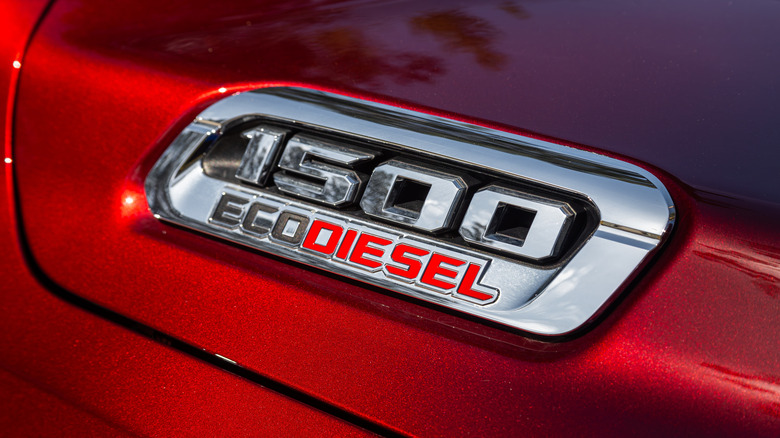What Kind Of MPG Does An EcoDiesel Engine Get? Here's What Drivers Say
Pickup trucks are incredible creations for many reasons. They are practical, durable, and versatile. Fuel economy, however, had never been one of those reasons, that is, until Ram introduced the EcoDiesel engine for its light-duty trucks in 2014. This marked a rather historic moment in the history of American pickup trucks, as the EcoDiesel engine was able to deliver impressive fuel economy without sacrificing the high torque of traditional diesels. The EcoDiesel swiftly found its way into the hoods of the Ram 1500 and Jeep Grand Cherokee, and over time expanded into the Jeep Wrangler and Gladiator, giving off-road enthusiasts a new way to combine trail-ready torque with long-range cruising efficiency.
Spanning two generations in the U.S., the EcoDiesel engine evolved to meet increasingly strict emissions standards while still promising strong towing capability and better mileage than gasoline competitors. However, real-world results don't always mirror the EPA's optimistic estimates. Depending on the model and driving habits, owners saw a wide range of fuel economy results, something that became more pronounced between the second and third-generation versions of the engine.
As diesel engines fell under increasing regulatory pressure, especially following well-publicized emissions scandals, manufacturers had to keep adapting their designs. The EcoDiesel was no exception to this, having undergone an overhaul between its second and third versions. Although fuel economy stayed a major selling point, actual mpg figures varied depending on the vehicle it was in and the way it was used.
Second-generation EcoDiesel: A strong start
The second-generation 3.0-liter V6 EcoDiesel debuted in 2014 under the hood of the Ram 1500 and Jeep Grand Cherokee. It promised best-in-class fuel economy for a full-size pickup, with EPA estimates of 20 mpg in the city and 27 mpg on the highway, with those figures dropping by 1 mpg each in four-wheel-drive guise. Jeep's Grand Cherokee diesel, meanwhile, posted similarly impressive ratings of 21 and 28 mpg for city and highway driving, respectively, appealing to SUV buyers looking for better range without sacrificing performance.
In practice, official test drives showed that the EcoDiesel often met — and sometimes exceeded — its highway mileage claims, especially during steady cruising. Ram 1500 EcoDiesel models regularly posted 30-plus mpg on extended highway trips, while the Grand Cherokee hovered closer to its EPA highway figures. However, city driving was less likely to surpass the EPA estimates, with some even reporting city mpg numbers in the mid-teens when dealing with frequent stops or towing heavy loads.
Owner-reported data on Fuelly offers a clearer picture of how widely fuel economy varied in the real world. Across hundreds of tracked vehicles, the 2014 Ram 1500 EcoDiesel most frequently averages 23.7 mpg, with many owners consistently hitting the mid-20s in mixed driving conditions. This being said, the distribution is quite large, with some drivers reporting averages as low as 15 mpg, particularly in urban settings or when towing, while others have managed to achieve impressive averages of 30 mpg or more. These stark differences illuminate just how much efficiency ratings are affected by factors like terrain, payload, and driving habits, while also showing that EPA estimates are helpful but not always an accurate representation of real-world scenarios.
Third-generation EcoDiesel: Evolution and end of the line
In 2020, Ram and Jeep introduced the redesigned third-generation EcoDiesel engine in response to emissions challenges and market shifts. The updated 3.0-liter V6 donned fresh internal components and new emissions technology, bumping up the power figures from 240 hp and 420 lb-ft of torque to 260 hp and 480 lb-ft of torque, while still retaining its efficiency. In the Ram 1500 2WD, the updated EcoDiesel was rated for up to 32 mpg on the highway and 22 mpg in the city, while the newly available Wrangler EcoDiesel promised 22 mpg in the city and up to 29 mpg on the highway under ideal conditions.
Official road tests confirmed the Ram 1500 EcoDiesel's impressive long-haul efficiency, often matching or slightly exceeding EPA numbers during highway trips. The Drive was even able to drive a 1500 EcoDiesel for a staggering 1000 miles on a single tank of fuel. Wrangler and Gladiator owners, however, found more mixed results. The heavier, boxier Wrangler often returned lower-than-expected city mpg — sometimes dipping below 20 mpg — though highway figures remained around 28–30 mpg.
According to driver data on Fuelly, the 2022 Ram 1500 EcoDiesel shows a similar range of real-world results, with a real-world average fuel economy of 24.6 mpg. This is a slight improvement over the second-gen engine and a fantastic average for a full-size truck. Results varied greatly, as with previous models, with some owners reporting averages as low as 14 mpg and as high as 33, but the third-gen EcoDiesel had a greater number of drivers reporting higher averages of 27-29 mpg. The variation emphasizes how important driving conditions and use cases still are for fuel economy, even if the now extinct third-generation EcoDiesel engine was slightly more refined.


